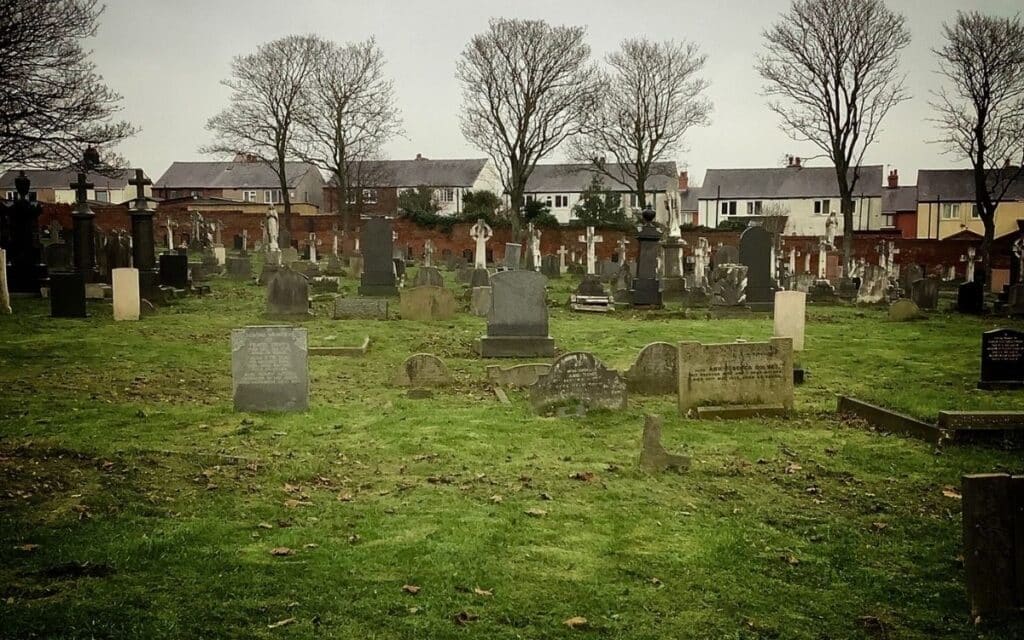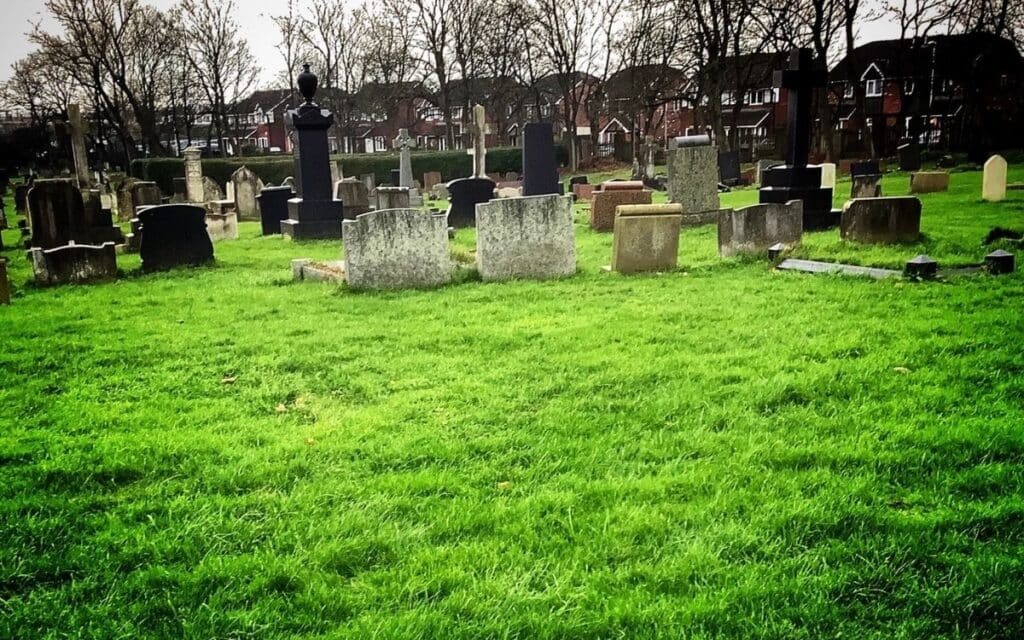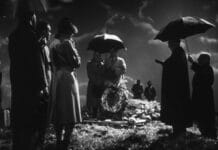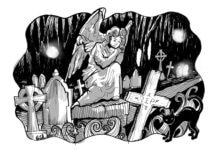DEBORAH CONTESSA debunks the common misconception that murderers and people who had committed suicide could never buried in consecrated ground…

Suicide was once considered the most shocking and blasphemous of actions, the “execution of felo de se” being both criminal and sinful.
However, this has not always been the case. Medical professionals were once generous in prescribing belladonna, hemlock and opium to patients suffering chronic and incurable diseases, in a bid to end their prolonged agony.
In ancient cultures, such as Roman and Greek, it was seen as a way of redeeming oneself from failure. Having to surrender in battle was quite literally a fate worse than death, so to perish by suicide was a prevalence preferred above dishonour on the battlefield.
Similarly, the ruling classes also chose death over dishonour if faced with public disgrace and humiliating scandal.
The upsurge of Christianity caused a startling reversal of thought on the matter, the act of suicide became a moralistic anathema. Viewed as a violation of God and unforgivable in this life and the next, it became seen as both a corporeal and spiritual crime. Those perishing at their own hand were prohibited from Christian burial and condemned to eternal anguish in the everlasting fires of Hell.
Can executed criminals and suicides be buried in consecrated ground?
It will then come as no surprise that people labour under the common misconception that those who have ended their own lives, or have deprived others of theirs, are unable to be laid to rest in ground that has been consecrated.
A convicted criminal executed for their crime(s) would indeed have ended up interred within the grounds of the gaol, where they were incarcerated when their death sentence was carried out.
However, it is not true that executed criminals could not be buried in consecrated ground. This only applied to those hanged for murder, and this was a rule quite often flouted!
Between 1752 and 1832, the bodies of executed murderers were legally denied burial in consecrated ground and instead were donated for anatomical dissection or displayed in a gibbet.
The practice of ignominious burials; those which did not take place in churchyards, cemeteries or consecrated burial grounds, was abolished in 1824. It was then agreed the interment of suicides and murderers could take place in a churchyard but only at night, and be conducted without religious rites.
By 1882, those who had taken their own lives were allowed to be buried during the hours of daylight.
Suicide, once considered a highly serious and wicked crime for well over a thousand years, was not actually decriminalised in England and Wales until 1961.
Many visitors to the wonderful Victorian cemetery in Layton, Blackpool, Lancashire, are frequently shocked and occasionally appalled to discover the final resting places of both murderers and those who died by suicide, dotted betwixt those of our most famous sons and daughters or their family and friends.
The sad tale of James Smith and Lily Ferris
Allow me, if you will, to recount the sad tale of James Smith and Lily Ferris, who felt compelled to end their existence and now lay resting in the cemetery where I am a guide:
As dawn broke on the bitterly cold morning of Tuesday, 16 December, 1930, two drowned bodies were discovered washed up on the beach, at South Shore, Blackpool, Lancashire. The couple were later to be identified as James Smith (aged 68) and Lily Lavinia Francis Ferris (52 years old).
James Smith was known locally as a widower. But it later came to light that when he first met Lily when he was married with daughters and living quite comfortably in Bristol, where he had worked as a train driver for many years.
Lily’s story, on the other hand, is more complex. It is believed she hailed from an affluent family as her baptism was conducted at St Paul’s Cathedral, yet her father was a bigamist who having married Lily’s mother also wed another woman some four years later. Both of his wives bore him a daughter and both of these baby girls were to be named Lily.
In 1899 Lily Lavinia married Tom Ferris, but when Tom went to serve in WWI she sought solace in the arms of an Australian soldier.
After this relationship had run its course, Lily was to meet James Smith, who had been advised to move to the coast for health reasons. James, having become besotted with Lily, decided to leave his family behind and make a fresh start at the seaside with her.
Lily too had recently discovered her health was in decline after receiving a diagnosis of epilepsy, so the couple made plans to settle in Lytham, Lancashire.
Not long after arriving on the Fylde Coast the couple found their finances to be in dire straits, forcing them to live in abject poverty.
Home became a makeshift shelter on the Sandhills at Blackpool, a small wooden hut James built himself. They scraped by, living hand to mouth, financing their meager existence by selling pieces of driftwood they found washed up on the shoreline as fuel to local people.
Sometime later Lily received the news her mother had died, leaving her a not insubstantial windfall of around £400, a huge amount of money during the depression of 1930. This sudden advantage enabled the pair to relocate to ‘Ivanhoe’, a property on Common Edge Lane with a small kiosk attached, from which they sold souvenirs and cigarettes alongside serving refreshments.
Astonishingly (and perhaps because the business saw little in passing trade), the couple still struggled to make ends meet, existing on a diet of only bread and margarine.
This strange yet steadfast couple took in lodgers, William Denton and his wife, to help eke out their existence (there was still a small mortgage to be paid on Ivanhoe).
It became obvious to James and The Dentons that something was seriously amiss with Lily, not only were her seizures becoming more frequent, she was also slowly starving to death.

Her weakened state and erratic behaviour caused James great distress. Then, after receiving a summons for knowingly selling stolen wood (of which he was later cleared) his mind must have been in absolute turmoil.
James was a man on the edge, his beloved partner was fading before his very eyes, he was without the funds to keep a roof over their heads and he was being hounded for unpaid rates.
For this now impoverished couple, there seemed to be only one solution, they made the heartbreaking decision to walk into the sea together, ending their own lives, thus unburdening themselves from the fear and failure circumstances had cruelly dealt them.
The funeral of James and Lily, at Layton Cemetery, Blackpool, was to be a quiet affair, attended only by Mr and Mrs Denton and the Reverend W. Lang who conducted the service in the pouring rain. They were laid to rest separately from each other, poor Lily taking up the last place in an unmarked pauper’s grave.
As suicide was against common law until 1961, this benevolent couple were considered criminals in death.
Upon James’ burial plot was placed a small wreath, bunch of chrysanthemums and a note reading;
“Man’s inhumanity to man makes countless thousands mourn.”
(a quote from “Man was Made to Mourn” by Robert Burns.)
It has often troubled me how the couple became so destitute after Lily’s ample inheritance, I find myself pondering where all the money went. It really is a mystery.
But getting answers won’t change the dreadful outcome of this tragedy.
Peculiar burial of Mr and Mrs Shaw
Another uncommonly peculiar burial at Layton was that of a married couple, Mr and Mrs Shaw.
In the early hours of 3 May 1905 , the bodies of a young couple were found on Watson Lane (now Watson Road). They had both been shot through the mouth with the back of their heads blown off by a revolver, which was discovered nearby. They were Elizabeth and Robert Shaw of Reads Avenue, Blackpool.
The stunningly attractive Elizabeth was just 24 years old, her husband 27 and together they had two beautiful children, a toddler son and a baby daughter.
The couple had enjoyed a good lifestyle and had no money worries (both came from wealthy backgrounds) but their relationship had become tempestuous. Robert had specified he only wanted to wed a ‘pure’ girl, so became incredibly distressed when his wife admitted to a dalliance before they had married.
Driven mad with jealousy it is believed Robert planned to slay his beautiful wife before taking his own life, although a suicide note found in his pocket stated “we have arranged to die together” .
Unusually, they are both laid to rest beside each other. It is incredibly rare for a murderer to be buried in consecrated ground. However, no one could be absolutely certain if this was a murder suicide or a suicide pact.
DEBORAH CONTESSA is a dilettante historian with a particular interest in all things dark and haunting, creepy and macabre. A taphophile tourist, graveyard detective, cemetery tour guide, paranormal enthusiast, interfaith minister, writer, artist and blogger. She is based in Blackpool, Lancashire and prefers her stories, ghosts and legends to have a local flavour. You can visit her website Beyond The Blackpool and follow her on twitter.








Wow what a richly told assortment of stories, superbly told, I too thought murderers and suicide victims were treated the same and unable to be interred in hallowed ground, thank you.
I also wonder what happened to the £400 windfall, why their problems persisted, thank you again.